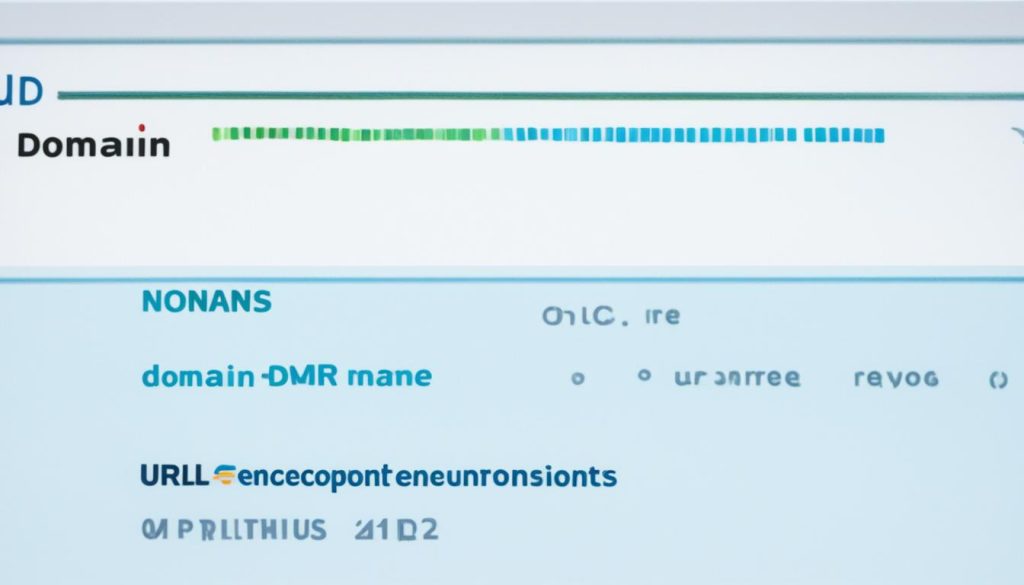What is a domain name? | Domain name vs. URL
Domain names are an integral part of our online experience, serving as the address through which we access websites on the internet. They play a crucial role in website identification and branding, providing a user-friendly alternative to complex IP addresses. But what exactly is a domain name, and how does it differ from a URL?
In this article, I will explore the definition and importance of domain names, as well as the function and differences between domain names and URLs. We will delve into the significance of these elements in website management, user experience, and secure browsing. Stay tuned to discover the key takeaways about domain names and URLs that will enhance your understanding of the internet landscape.
Key Takeaways:
- A domain name is an internet resource name that locates an organization or entity on the internet.
- Domain names are unique identifiers that are more user-friendly than IP addresses.
- URLs are complete web addresses used to locate specific web pages within a website.
- A domain name is part of a URL, but they serve different purposes in website identification.
- Understanding domain names and URLs is crucial for effective website management and user experience.
Understanding Domain Names
A domain name is a crucial element of a website’s identity on the internet. It refers to the text form of an IP address, making it more user-friendly and easy to remember. A domain name is composed of three primary parts: the root domain, the top-level domain (TLD), and the second-level domain.
The root domain is the main web address that represents the website. It typically corresponds to the brand or organization’s name. For example, in the domain name “example.com,” “example” is the root domain.
The top-level domain (TLD) is the suffix or extension that is tied to the website. It denotes the website’s purpose or geographic location. Common TLDs include .com, .org, and .ca. For instance, in the domain name “example.com,” “.com” is the TLD.
The second-level domain is the site name that comes before the TLD. It can be customized to reflect the brand or specific purpose of the website. In the domain name “example.com,” “example” is the second-level domain.
Domain names play a vital role in branding and representing organizations or entities on the internet. They provide a memorable and recognizable way for internet users to access specific websites without having to remember complex IP addresses. A well-chosen domain name can enhance a website’s visibility, credibility, and overall user experience.
Let’s take a closer look at the components of a domain name:
| Component | Example |
|---|---|
| Root Domain | example |
| Top-Level Domain (TLD) | .com |
| Second-Level Domain | example.com |
Understanding the structure and significance of domain names is essential for individuals and businesses alike. By having a clear understanding of domain names, one can make informed decisions when choosing, managing, and utilizing them to establish a strong online presence.
The Function of URLs
A URL, or Uniform Resource Locator, is a complete web address that is used to find a specific web page. It consists of the domain name and other important components such as the protocol, subdomain, port, and path.
The protocol indicates the method used for retrieving the file from the server. It can be HTTP (Hypertext Transfer Protocol) or HTTPS (HTTP Secure) for secure communication. The subdomain represents a specific section of the website and can provide additional context or organization to the URL.
URLs serve an essential function in web browsing by allowing users to directly access specific pages or content on a website without having to navigate from the start. They provide a convenient way to share links and access specific resources on the internet.
For example, consider the URL:
https://www.example.com/blog/interesting-article
In this URL, “https” is the protocol, “www” is the subdomain, “example.com” is the domain name, “/blog” is the path, and “/interesting-article” is the specific page or content being accessed.
Understanding URLs is important for navigating the web effectively and efficiently. By familiarizing ourselves with all the components of a URL, we can access the information we need with ease.

| Component | Description |
|---|---|
| Protocol | Indicates the method used for retrieving the file from the server |
| Subdomain | Represents a specific section of the website |
| Domain Name | Unique identifier for an organization or entity on the internet |
| Path | Specifies the location of a specific page or content on the website |
Differences Between Domain Names and URLs
When it comes to website identification, domain names and URLs play distinct roles. Understanding the differences between these two components is essential for navigating the internet effectively.
A domain name is a human-friendly text form of an IP address. It serves as a branding tool and represents organizations on the internet. For example, if we consider the domain name “example.com,” it provides a recognizable and unique identity for the website.
On the other hand, a URL is a complete web address that includes the domain name and other necessary components to locate a specific web page or resource.
Let’s break it down further with an example:
- Domain Name: example.com
- URL: https://example.com/pages/contact
In this case, the domain name is “example.com,” while the URL provides a more specific address to access the contact page on the website.
While the domain name focuses on identifying a website, the URL allows users to directly access specific pages or content within that website. It provides a more precise destination for internet users.
Here’s a visual representation of the differences between domain names and URLs:

| Domain Name | URL |
|---|---|
| Identifies a website | Specifies a specific web page or resource |
| Human-friendly text form of an IP address | Complete web address with necessary components |
| Branding and representation tool | Precise destination for accessing content |
Importance of Domain Names and URLs
In the world of websites and the internet, domain names and URLs play vital roles in ensuring effective online presence and user experience. Let’s delve into the significance of domain names and URLs, and how they contribute to the success of a website.
Domain Name Importance
A domain name serves as a unique identifier for an organization or entity on the internet. It plays a crucial role in branding and helps establish a strong online presence. A memorable and relevant domain name can make it easier for users to find and remember a website. It reflects the personality, purpose, and values of the organization, making it more recognizable and trustworthy.
Domain Name Benefits
The benefits of a well-chosen domain name extend beyond mere identification. A carefully selected domain name can contribute to higher search engine rankings, making it easier for users to find the website. It can enhance click-through rates and improve organic traffic. Additionally, a domain name that aligns with the organization’s brand can foster credibility and trust among users, leading to increased conversions and customer loyalty.
Domain Name Relevance
Domain name relevance is crucial for attracting the right audience. A domain name that accurately reflects the content, products, or services offered by a website helps target the desired demographic. It helps users quickly understand what the website is about, reducing bounce rates and increasing engagement. A relevant domain name also improves the chances of potential customers finding the website through organic search or direct navigation.
In summary, domain names and URLs are essential components of a successful website. They contribute to branding, visibility, and user experience. By understanding the importance and leveraging the benefits of domain names and URLs, organizations can enhance their online presence and effectively connect with their target audience.
The Impact of Country-Specific TLDs
Each country has its own domain names organized based on a hierarchy. Internet domain names come in several types, including top-level domains (TLDs), second-level domains, third-level domains, and country domains. Country-specific TLDs are designated for each nation and have unique two-letter alphabetic codes. The TLDs indicate the specific country or region to which a domain name is associated. This distinction can be important for organizations that have a presence in multiple countries or need to target specific geographic audiences.
Country-specific TLDs play a significant role in establishing a website’s relevance to a particular target audience. When users see a country-specific TLD, such as “.ca” for Canada or “.uk” for the United Kingdom, it instantly communicates that the website is tailored to or operated within that specific country or region. This can help build trust and credibility among visitors who are seeking localized information, products, or services.
Furthermore, search engines often prioritize country-specific TLDs when delivering search results for users within a specific country or region. This means that websites with country-specific TLDs have a higher chance of appearing in search results when users conduct geographically targeted searches. It enhances the website’s visibility and reach among the intended audience, which can lead to increased traffic and potential customers.
For businesses or organizations that operate in multiple countries, having country-specific TLDs can also help differentiate their websites and establish a localized online presence. It ensures that users can easily identify the relevant website for their specific location, fostering a sense of connection and familiarity.
In summary, country-specific TLDs are essential for organizations looking to target specific geographic audiences and establish credibility within a particular country or region. These domain names play a crucial role in signaling relevance, improving search engine visibility, and creating a localized online presence. Consideration of country-specific TLDs should be part of a comprehensive domain name strategy to maximize the impact and effectiveness of a website.
Understanding HTTPS and DNS in URLs
When it comes to browsing the web, URLs are essential in establishing secure connections and ensuring smooth functionality of the Domain Name System (DNS). I want to shed some light on the significance of these elements in our online experience.
First, let’s talk about HTTPS, which stands for Hyper Text Transfer Protocol Secure. It’s a secure protocol that uses TLS/SSL certificates to authenticate the data flow between your browser and the server you are accessing. By utilizing HTTPS, your information is encrypted, protecting your privacy and ensuring the integrity of your data exchange.
Now, let’s shift our focus to DNS, the system that translates domain names into the IP addresses necessary for browsers to connect with the appropriate web servers. It acts as a bridge, linking the user-friendly domain names we are familiar with to the backend infrastructure of the internet. Without DNS, browsing the web would be a lot more complicated.
Understanding the relationship between URLs, HTTPS, and DNS is crucial for secure and efficient web browsing. Together, they work seamlessly to provide us with trusted connections, safeguard our data, and ensure we can easily navigate the internet. So, the next time you visit a website, remember the role these technologies play in delivering a safe and reliable online experience.
FAQ
What is a domain name?
What is the difference between a domain name and a URL?
Why are domain names important?
What is the function of a URL?
What are the differences between domain names and URLs?
Why are domain names and URLs important?
What is the impact of country-specific TLDs?
How does HTTPS and DNS impact URLs?
- How Strategic SEO Drove Growth for a CPAP E-commerce Brand - July 24, 2025
- Top 3 SEO Companies in Toronto: An Analytical Comparison - July 23, 2025
- SEO for Entry Door Services - April 24, 2025





















Post Comment
You must be logged in to post a comment.